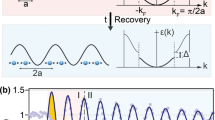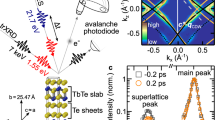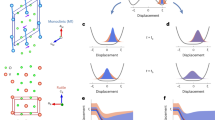Abstract
Topological defects play a central role in dynamical systems undergoing a non-adiabatic transition. In solids, topological defects as a result of femtosecond laser excitation have attracted increasing interest not only because they are key to understanding phase transitions but also because they can generate a variety of hidden orders that are not accessible in thermal equilibrium. Despite the common occurrence of these defects in a non-equilibrium system, the fundamental limit on how fast they can emerge in solids and the generic pathway for defect creation at such fast timescales have remained open questions. Here we apply ultrafast electron diffraction to study the reciprocal-space signatures of transient defects in a two-dimensional charge density wave, where simultaneous measurements of both defect and phonon dynamics yield a microscopic view of defect formation in the femtosecond regime. We find that one-dimensional domain walls are generated well within 1 ps following photoexcitation, during which the defect growth is not dictated by the amplitude of the order parameter, but is mediated by a non-thermal population of longitudinal optical phonons. Our work provides a framework for the ultrafast engineering of topological defects that are coupled to specific collective modes, which will prove useful for the dynamical control of non-equilibrium phases in correlated materials.
This is a preview of subscription content, access via your institution
Access options
Access Nature and 54 other Nature Portfolio journals
Get Nature+, our best-value online-access subscription
$29.99 / 30 days
cancel any time
Subscribe to this journal
Receive 12 print issues and online access
$209.00 per year
only $17.42 per issue
Buy this article
- Purchase on Springer Link
- Instant access to full article PDF
Prices may be subject to local taxes which are calculated during checkout




Similar content being viewed by others
Data availability
All data supporting the conclusions are available within the article and its Supplementary Information. Additional data are available from the corresponding authors upon reasonable request.
References
Yusupov, R. et al. Coherent dynamics of macroscopic electronic order through a symmetry breaking transition. Nat. Phys. 6, 681–684 (2010).
Zong, A. et al. Ultrafast manipulation of mirror domain walls in a charge density wave. Sci. Adv. 4, eaau5501 (2018).
Duan, S. et al. Optical manipulation of electronic dimensionality in a quantum material. Nature 595, 239–244 (2021).
Stojchevska, L. et al. Ultrafast switching to a stable hidden quantum state in an electronic crystal. Science 344, 177–180 (2014).
Gerasimenko, Y. A., Karpov, P., Vaskivskyi, I., Brazovskii, S. & Mihailovic, D. Intertwined chiral charge orders and topological stabilization of the light-induced state of a prototypical transition metal dichalcogenide. npj Quantum Mater. 4, 32 (2019).
Kogar, A. et al. Light-induced charge density wave in LaTe3. Nat. Phys. 16, 159–163 (2020).
Vogelgesang, S. et al. Phase ordering of charge density waves traced by ultrafast low-energy electron diffraction. Nat. Phys. 14, 184–190 (2018).
Zong, A. et al. Evidence for topological defects in a photoinduced phase transition. Nat. Phys. 15, 27–31 (2019).
Laulhé, C. et al. Ultrafast formation of a charge density wave state in 1T-TaS2: observation at nanometer scales using time-resolved X-ray diffraction. Phys. Rev. Lett. 118, 247401 (2017).
Chuang, I., Durrer, R., Turok, N. & Yurke, B. Cosmology in the laboratory: defect dynamics in liquid crystals. Science 251, 1336–1342 (1991).
Bowick, M. J., Chandar, L., Schiff, E. A. & Srivastava, A. M. The cosmological Kibble mechanism in the laboratory: string formation in liquid crystals. Science 263, 943–945 (1994).
Orihara, H. & Ishibashi, Y. Dynamics of disclinations in twisted nematics quenched below the clearing point. J. Phys. Soc. Jpn 55, 2151–2156 (1986).
Nagaya, T., Hotta, H. & Oriharaand Yoshihiro Ishibashi, H. Experimental study of the coarsening dynamics of +1 and −1 disclinations. J. Phys. Soc. Jpn 61, 3511–3517 (1992).
Nakai, A., Shiwaku, T., Wang, W., Hasegawa, H. & Hashimoto, T. Phase-separated structures formed in polymer mixtures containing a thermotropic liquid crystalline copolyester as one component. Polymer 37, 2259–2272 (1996).
Nelson, D. R. & Halperin, B. I. Dislocation-mediated melting in two dimensions. Phys. Rev. B 19, 2457–2484 (1979).
Dai, H., Chen, H. & Lieber, C. M. Weak pinning and hexatic order in a doped two-dimensional charge-density-wave system. Phys. Rev. Lett. 66, 3183–3186 (1991).
Soumyanarayanan, A. et al. Quantum phase transition from triangular to stripe charge order in NbSe2. Proc. Natl Acad. Sci. USA 110, 1623–1627 (2013).
Ma, L. et al. A metallic mosaic phase and the origin of Mott-insulating state in 1T-TaS2. Nat. Commun. 7, 10956 (2016).
Cho, D. et al. Nanoscale manipulation of the Mott insulating state coupled to charge order in 1T-TaS2. Nat. Commun. 7, 10453 (2016).
Chaikin, P. M. & Lubensky, T. C. Principles of Condensed Matter Physics (Cambridge Univ. Press, 1995).
Qi, F. et al. Breaking 50 femtosecond resolution barrier in MeV ultrafast electron diffraction with a double bend achromat compressor. Phys. Rev. Lett. 124, 134803 (2020).
Stern, M. J. et al. Mapping momentum-dependent electron-phonon coupling and nonequilibrium phonon dynamics with ultrafast electron diffuse scattering. Phys. Rev. B 97, 165416 (2018).
Chen, P. et al. Hidden order and dimensional crossover of the charge density waves in TiSe2. Sci. Rep. 6, 37910 (2016).
Cheng, Y. et al. Light-induced dimension crossover dictated by excitonic correlations. Nat. Commun. 13, 963 (2022).
Zhu, P. et al. Femtosecond time-resolved MeV electron diffraction. New J. Phys. 17, 063004 (2015).
Otto, M. R. et al. Mechanisms of electron-phonon coupling unraveled in momentum and time: the case of soft phonons in TiSe2. Sci. Adv. 7, eabf2810 (2021).
Domröse, T. et al. Light-induced hexatic state in a layered quantum material. Nat. Mater. https://doi.org/10.1038/s41563-023-01600-6 (2023).
Tarkhov, A. E., Rozhkov, A. V. & Fine, B. V. Dynamics of topological defects after photoinduced melting of a charge density wave. Phys. Rev. B 106, L121109 (2022).
van Wezel, J., Nahai-Williamson, P. & Saxena, S. S. Exciton-phonon-driven charge density wave in TiSe2. Phys. Rev. B 81, 165109 (2010).
Porer, M. et al. Non-thermal separation of electronic and structural orders in a persisting charge density wave. Nat. Mater. 13, 857–861 (2014).
Zong, A. et al. Role of equilibrium fluctuations in light-induced order. Phys. Rev. Lett. 127, 227401 (2021).
Wall, S. et al. Ultrafast disordering of vanadium dimers in photoexcited VO2. Science 362, 572–576 (2018).
Zhang, Y. et al. Creation of a novel inverted charge density wave state. Struct. Dyn. 9, 014501 (2022).
Xu, R. & Chiang, T. C. Determination of phonon dispersion relations by X-ray thermal diffuse scattering. Z. Krist. Cryst. Mater. 220, 1009–1016 (2005).
de la Torre, A. et al. Colloquium: nonthermal pathways to ultrafast control in quantum materials. Rev. Mod. Phys. 93, 041002 (2021).
Acknowledgements
We thank Y. He and D. Limmer for helpful discussions. We thank J.-H. Pöhls for providing the calculated phonon dispersions26 and L. P. René de Cotret for providing the Python codes for computing the one-phonon structure factor22. D.X. and J.Z. acknowledge support from the National Key R&D Program of China (no. 2021YFA1400202); the National Natural Science Foundation of China (grant nos. 11925505, 11504232 and 11721091); and the Office of Science and Technology, Shanghai Municipal Government (no. 16DZ2260200). A.Z. acknowledges support from the Miller Institute for Basic Research in Science. L.W., Q.M. and Y.Z. acknowledge support from the US Department of Energy, Basic Energy Sciences, Materials Sciences and Engineering Division, under Contract No. DE-SC0012704. Y.G. acknowledges support from the National Natural Science Foundation of China (grant no. 11874264). A.K. acknowledges support from the US Department of Energy (DOE), Office of Science, Office of Basic Energy Sciences under Award No. DE-SC0023017. M.W.Z. acknowledges funding by the W. M. Keck Foundation, funding from the UC Office of the President within the Multicampus Research Programs and Initiatives (M21PL3263), the Hellman Fellows Fund and the National Science Foundation (NSF-DMR 2247363).
Author information
Authors and Affiliations
Contributions
A.Z., D.X. and Y.C. conceived the project. Y.C., A.Z., L.W. and Y.Z. analysed the data with important theoretical insights from J.v.W. and A.K. W.X. and Y.G. grew the single crystals. Y.C. collected the ultrafast electron diffraction data, where the MeV ultrafast electron diffraction beamline was constructed and maintained by F.Q., P.Z., X.Z. and T.J. L.W., Q.M. and Y.C. performed the diffraction simulations. A.Z. and Y.C. wrote the paper with critical input from A.K., M.W.Z., Y.Z., D.X. and all other authors. The project was supervised by M.W.Z., J.Z., Y.Z. and D.X.
Corresponding authors
Ethics declarations
Competing interests
The authors declare no competing interests.
Peer review
Peer review information
Nature Physics thanks Isabella Gierz, Dragan Mihailović and the other, anonymous, reviewer(s) for their contribution to the peer review of this work.
Additional information
Publisher’s note Springer Nature remains neutral with regard to jurisdictional claims in published maps and institutional affiliations.
Supplementary information
Supplementary Information
Supplementary Notes 1–10, Figs. 1–16, Equations 1–7, Table 1, caption of Supplementary Video 1 and References.
Supplementary Video 1
Photoinduced change in the diffraction pattern of 1T-TiSe2 following the incidence of a 3 mJ cm–2, 800 nm pulse, taken at 210 K. To prevent colour saturation at later times, the colour scale also varies with the pump–probe delay. The hexagons mark the Brillouin zones and images in each frame are symmetrized to enhance the statistics.
Rights and permissions
Springer Nature or its licensor (e.g. a society or other partner) holds exclusive rights to this article under a publishing agreement with the author(s) or other rightsholder(s); author self-archiving of the accepted manuscript version of this article is solely governed by the terms of such publishing agreement and applicable law.
About this article
Cite this article
Cheng, Y., Zong, A., Wu, L. et al. Ultrafast formation of topological defects in a two-dimensional charge density wave. Nat. Phys. 20, 54–60 (2024). https://doi.org/10.1038/s41567-023-02279-x
Received:
Accepted:
Published:
Issue Date:
DOI: https://doi.org/10.1038/s41567-023-02279-x
This article is cited by
-
Spot the defects
Nature Physics (2024)



